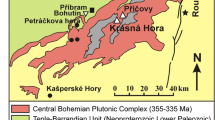Abstract
Epithermal precious metal deposits have only quite recently been added to the metallogenic view of Italy. It was only in the late 1980s that two districts were recognized, in Sardinia and southern Tuscany, previously long known for a large variety of other commodities. The Sardinian epithermal precious metal district is associated with the Oligocene-Miocene Sardinian calc-alkaline magmatic cycle. The most relevant areas include the Au deposit at Furtei, already in production, and the Osilo prospect, where extensive exploration is under way. The deposit at Furtei contains at least six tonnes of gold metal. The mineralogy of the deposit and of the alteration assemblages is typical of the acid-sulfate (high-sulfidation) class of volcanic-hosted epithermal deposits. Fluids associated with alteration and mineralization have moderate temperatures (200–300 °C) and low salinities (less than 6% wt. NaCl equivalent); high-temperature, high-salinity fluids similar to porphyry-style systems also circulated at Furtei. At Osilo, a number of quartz veins containing up to several ppm Au have been identified. The alteration assemblage includes adularia and illite, i.e. is typical of low-sulfidation deposits. Fluid inclusion homogenization temperatures range from 198 to 270 °C, with salinities of less than 4% wt. NaCl equivalent.
In southern Tuscany, a number of carbonate-hosted (“Carlin type”) gold showings occur at the edges of the geothermal fields of Larderello, Amiata and Latera, an area previously known for Sb mineralization. In fact, many showings coincide with former Sb mines, and stibnite, along with pyrite, is the most common sulfide mineral. Gold is typically invisible. Fluids hosted in a variety of minerals from these occurrences span a relatively large temperature range (132 to 245 °C), with constantly low salinities (less than 7% wt. NaCl equivalent). The onset of (presumably meteoric) hydrothermal fluid circulation can be ascribed to the emplacement of Neogene Tuscan magmatic rocks, but the ultimate source of gold remains speculative.
Similar content being viewed by others
Author information
Authors and Affiliations
Additional information
Received: 13 October 1998 / Accepted: 5 February 1999
Rights and permissions
About this article
Cite this article
Lattanzi, P. Epithermal precious metal deposits of Italy–an overview. Mineral. Deposita 34, 630–638 (1999). https://doi.org/10.1007/s001260050224
Issue Date:
DOI: https://doi.org/10.1007/s001260050224




